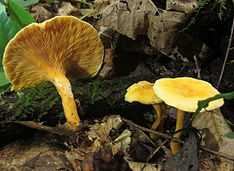Hygrophoropsis aurantiaca
| False chanterelle | |
|---|---|
 |
|
| Scientific classification | |
| Kingdom: | Fungi |
| Division: | Basidiomycota |
| Class: | Agaricomycetes |
| Order: | Boletales |
| Family: | Hygrophoropsidaceae |
| Genus: | Hygrophoropsis |
| Species: | H. aurantiaca |
| Binomial name | |
|
Hygrophoropsis aurantiaca (Wulfen) Maire (1921) |
|
| Synonyms | |
|
|
| Hygrophoropsis aurantiaca | |
|---|---|
| Mycological characteristics | |
| gills on hymenium | |
|
|
cap is depressed or infundibuliform |
| hymenium is decurrent | |
| stipe is bare | |
|
|
spore print is white to cream |
| ecology is saprotrophic | |
| edibility: not recommended | |
cap is depressed
spore print is white
Hygrophoropsis aurantiaca, commonly known as the false chanterelle, is a species of fungus in the family Hygrophoropsidaceae. It is found across several continents, growing in woodland and heathland, and sometimes on woodchips used in gardening and landscaping. Fruit bodies (mushrooms) are yellow–orange with a funnel-shaped cap up to 8 cm (3 1⁄8 in) across that has a felt-like surface. The thin, often forked gills on the underside of the cap run partway down the length of the otherwise smooth stipe. Reports on the mushroom's edibility vary – it can serve as food, though not a particularly flavorful one, or it can be mildly poisonous.
Austrian naturalist Franz Xaver von Wulfen described the false chanterelle in 1781, noting both its resemblance with the true chanterelles and people's propensity to confuse them. The false chanterelle was then placed in the genus , but it was later observed that its forked gills and dextrinoid spores indicated a relationship to Paxillus. Genetic analysis has confirmed that it belongs to the order Boletales and is more closely related to boletes.
Austrian naturalist Franz Xaver von Wulfen described the false chanterelle as Agaricus aurantiacus in 1781, reporting that it appeared in the fir tree forests around Klagenfurt in October. He added that it could be confused with the chanterelle by the inexperienced, but that its true nature was very different; in contrast to its edible lookalike, he described it as "kind of pernicious". The specific epithet is the Latin word aurantiacus, meaning "orange".James Sowerby illustrated it and gave it the name Agaricus subcantharellus, describing it as a "perhaps unfavourable" variety of A. cantharellus (chanterelle). The fungus was placed in the genus Merulius by Johann Friedrich Gmelin in 1792, and then Cantharellus by Elias Fries in 1821.Bernhard Studer-Steinhäuslin concluded it could only be classified in the genus in 1900, based on its white spores, decurrent gills and lack of a ring. It was elevated to the status of genus in Emile Martin-Sans' 1929 publication L'Empoisonnement par les champignons et particulièrement les intoxications dues aux Agaricacées du groupe des Clitocybe et du groupe des Cortinarius, with authorship attributed to René Maire. Martin-Sans concurred with Maire's assessment of Hygrophoropsis, suggesting that it represented a form intermediate between Cantharellus and Clitocybe, and was thus worthy of generic ranking. The genus name refers to a resemblance to the genus Hygrophorus. It is commonly known as the false chanterelle.
...
Wikipedia
